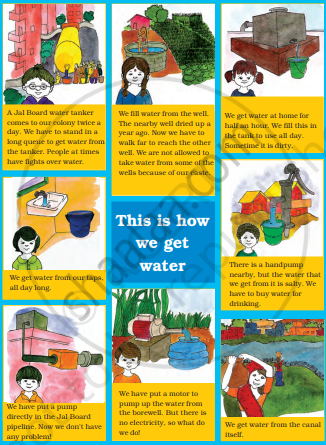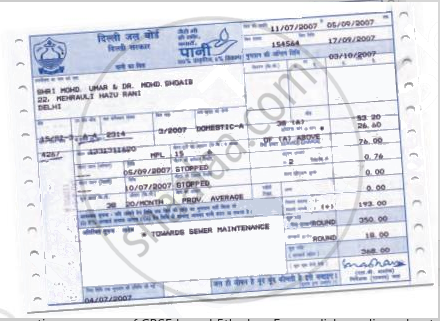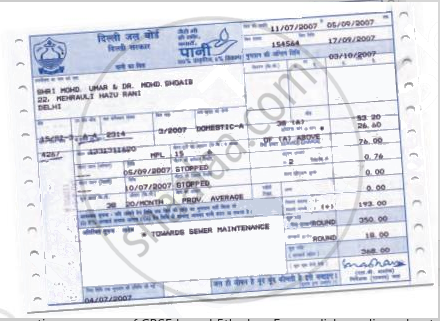Advertisements
Chapters
2: A Snake Charmer’s Story
3: From Tasting to Digesting
4: Mangoes Round the Year
5: Seeds and Seeds
▶ 6: Every Drop Counts
7: Experiments with Water
8: A Treat for Mosquitoes
9: Up You Go!
10: Walls Tell Stories
11: Sunita in Space
12: What if it Finishes ...?
13: A Shelter so High!
14: When the Earth Shook!
15: Blow Hot, Blow Cold
16: Who will do this Work?
17: Across the Wall
18: No Place for Us?
19: A Seed tells a Farmer’s Story
20: Whose Forests?
21: Like Father, Like Daughter
22: On the Move Again
![NCERT solutions for Environmental Studies - Looking Around [English] Class 5 chapter 6 - Every Drop Counts NCERT solutions for Environmental Studies - Looking Around [English] Class 5 chapter 6 - Every Drop Counts - Shaalaa.com](/images/environmental-studies-looking-around-english-class-5_6:71bdf81a5f57474cb6fe25f9506ae503.jpg)
Advertisements
Solutions for Chapter 6: Every Drop Counts
Below listed, you can find solutions for Chapter 6 of CBSE NCERT for Environmental Studies - Looking Around [English] Class 5.
NCERT solutions for Environmental Studies - Looking Around [English] Class 5 6 Every Drop Counts Every Drop Counts [Pages 52 - 59]
Observe and find out
Look at the area around your school. Are there any fields, farms, pucca roads, drains, etc? Is the area sloping, rocky, or flat? Think, what will happen here when it rains? Where will the rain water go – into the drains, pipes, or pits? Is some water also getting soaked into the soil?
Drop-by-drop
How do you think the rainwater that falls on the roof will reach the underground tank? Draw the path.
Have you ever faced a shortage of water in your area? If yes, then what was the reason for it?
Talk to your grandmother or any elderly person. Find out, when they were of your age:
From where did they get water for the house? Has there been a change now?
Talk to your grandmother or an elderly person. Find out, when they were of your age:
What kind of water arrangements were made for travellers - for example, piau, Mashak (leather bag), or any other? Now, what do people do about water when they travel?
Customs related to water
Can we even imagine life without water?
Do you have some special pots for water at your place?
Have you ever seen any beautiful building near the place of water? Where?
Find out
Is there a lake, well or stepwell near your house or school? Visit it and find out more about it.
How old is it? Who got it built?
Is there a lake, well or stepwell near your house or school? Visit it and find out more about it.
What kinds of buildings are around it?
Is there a lake, well or stepwell near your house or school? Visit it and find out more about it.
Is the water clean? Is it cleaned regularly?
Is there a lake, well or stepwell near your house or school? Visit it and find out more about it.
Who all use the water?
Is there a lake, well or stepwell near your house or school? Visit it and find out more about it.
Is there any festival celebrated at this place?
Is there a lake, well or stepwell near your house or school? Visit it and find out more about it.
Is there any water today, or is it dry?
Discuss
There are two old wells in the area where Punita lives. Her grandmother says that about fifteen-twenty years ago there was water in these wells. The wells could have dried up because:
- Water is being pumped up from under the ground, with the help of electric motors.
- The lakes in which rainwater used to collect are no longer there.
- The soil around trees and parks is now covered with cement.
- Is there some other reason for this? Explain.
The story today
Let us see the different ways in which people manage water today. See the picture give below and discuss.
Do you get water in your house in any of these ways? Put a tick (✓) on that. If you get water in some other way, write in your notebook.

Discuss
Everyone has the right to live. Yet, is everybody getting enough water to live or even water to drink? Why is it that some people have to buy drinking water? Should it be like this? Water on this earth is for one and all. Some people draw out water from the ground by deep bore wells. How far is it correct? Have you ever seen this? Why do some people put a pump directly in the Jal Board pipeline? What problems would other people face due to this? Do you have any such experience?
Look at this bill and tell
From which office has this bill come?

Do you get a water bill at home? Find out from where it is sent?
Why do you think Dilli Sarkar (Government of Delhi) is written under Delhi Jal Board?
In whose name is the bill? How much money do they have to pay for each month?

Do you have to pay for water? How much? Is the rate of water different in different colonies? Ask your elders.
It can be done
Have you ever read this kind of news in any newspaper? How did people solve their problem of water? Did they repair and reuse any old lake or stepwell?
What we have learnt
Make a poster: Do you remember the slogan – “Water on earth is for one and all.” Think of some other such slogans.
Draw pictures and make a nice poster.
What we have learnt
Bring a water bill, look at it and tell –
This bill is from ______ date to ______ date.
Bring a water bill, look at it and tell -
How much money is to be paid for this bill?
Bring a water bill, look at it and tell -
What else can you see in the bill, like the money spent on repair, maintenance, etc.?
Solutions for 6: Every Drop Counts
![NCERT solutions for Environmental Studies - Looking Around [English] Class 5 chapter 6 - Every Drop Counts NCERT solutions for Environmental Studies - Looking Around [English] Class 5 chapter 6 - Every Drop Counts - Shaalaa.com](/images/environmental-studies-looking-around-english-class-5_6:71bdf81a5f57474cb6fe25f9506ae503.jpg)
NCERT solutions for Environmental Studies - Looking Around [English] Class 5 chapter 6 - Every Drop Counts
Shaalaa.com has the CBSE Mathematics Environmental Studies - Looking Around [English] Class 5 CBSE solutions in a manner that help students grasp basic concepts better and faster. The detailed, step-by-step solutions will help you understand the concepts better and clarify any confusion. NCERT solutions for Mathematics Environmental Studies - Looking Around [English] Class 5 CBSE 6 (Every Drop Counts) include all questions with answers and detailed explanations. This will clear students' doubts about questions and improve their application skills while preparing for board exams.
Further, we at Shaalaa.com provide such solutions so students can prepare for written exams. NCERT textbook solutions can be a core help for self-study and provide excellent self-help guidance for students.
Concepts covered in Environmental Studies - Looking Around [English] Class 5 chapter 6 Every Drop Counts are Every Drop Counts.
Using NCERT Environmental Studies - Looking Around [English] Class 5 solutions Every Drop Counts exercise by students is an easy way to prepare for the exams, as they involve solutions arranged chapter-wise and also page-wise. The questions involved in NCERT Solutions are essential questions that can be asked in the final exam. Maximum CBSE Environmental Studies - Looking Around [English] Class 5 students prefer NCERT Textbook Solutions to score more in exams.
Get the free view of Chapter 6, Every Drop Counts Environmental Studies - Looking Around [English] Class 5 additional questions for Mathematics Environmental Studies - Looking Around [English] Class 5 CBSE, and you can use Shaalaa.com to keep it handy for your exam preparation.
